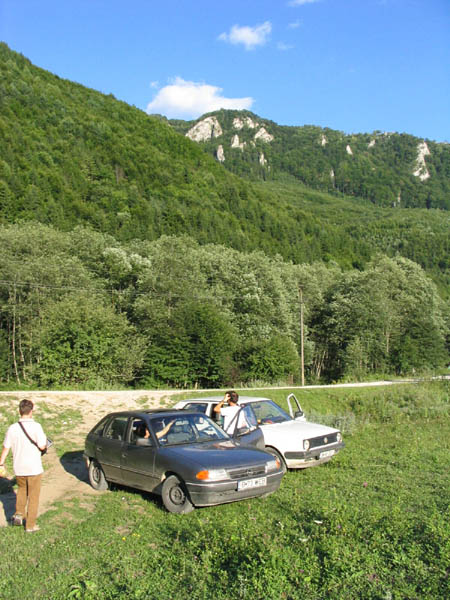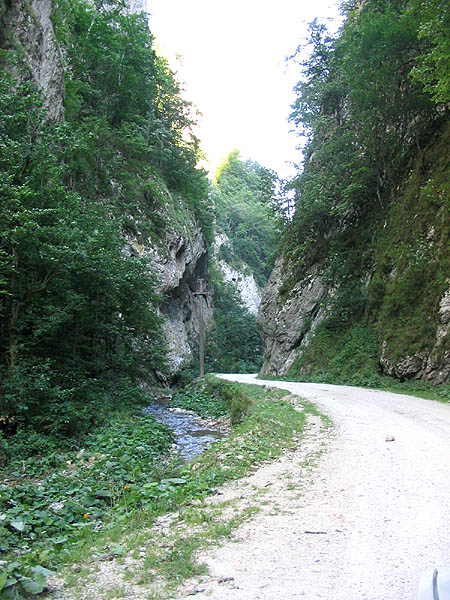Buila-Vinturarita Mountains
Monasteries, people, landscapes
|
August, 2003
|
Buila-Vinturarita range, part of the Capatinii Mountains, is a less touristic destination, but it features pleasant surprises for any visitor.
It lies about 200 km NW from Bucharest and thus it can be an interesting weekend destination.
Leaving behind Pitesti and Rimnicu Vilcea towns, we head towards the Cheia village, on the road that branches to the left
off the main road Rimnicu Vilcea - Baile Olanesti.
|

|
Our first stop after the Cheia village is the tiny and beatiful Iezer monastery.
Built in 1559, the monastery welcomes us with its small but colorful court, full of flowers of all kinds. Both this court
and the lanscape - green lush hills - are so definitory for the Romanian monasteries.
|
|
A nun shows us a back exit from the court. This leads to the cave where Saint Antonie from Iezer - the builder of the church - lived a part of his life.
The path to his cave climbs a steep slope, through a forest spotted with sunlit clearings.
|

|

|

|
The cave where the Saint lived is dug in the tough rock of the mountain. Recently, a cement entrance has been built and
a sign reminds the visitor about the holy dweller of this place. From the entrance looking back, a beautiful panorama opens to our eyes:
valleys and smooth ranges covered with green woods.
|
|
Back to the Iezer monastery, we admire once more the pansy and we continue the trip.
The cars head farther on the country road towards the Buila range, along the Cheia river.
Few minutes later we pass by the Pahomie hermitage, a beautiful symbiosis between the mountain rock and
a simple, wonderful church. Since it's getting late, we don't stop and promise ourselves to visit the
place when we get back, after a few days.
|

|
|
But soon after the Pahomie hermitage, the road becomes unusable, so we park the cars in a clearing and we continue our
trip on foot.
We follow the narrow drawn in the lateral of a green steep slope. The path seems to lead to the ridge which appears suddenly
in front of us, among smooth green slopes. Our destination is at the foot of that ridge.
|

|

|
In less than one hour walk from the Pahomie hermitage, another man-made marvel lies in front of us, at the foot of the
Buila range: the Patrunsa monastery.
This monastery, besides the small white church typical for this region, comprises a number of small wooden houses scattered
around the monastery compound. Their dwellers are the monks of the Patrunsa monastery.
The extraordinary devotion of these people assisted them in building the monastery with rocks and wood transported by a few mules.
There are no roads for cars, not to mention trucks. But there is belief and will.
In line with the good old tradition of the Romanian monasteries, here you can get free shelter and free food. The conditions
are simple, but it's cosy and clean. And the landscape you see out of the window is magnificent !
|
|
But we have the tents with us, so we decide to camp about 200 meters away from the monastery compound, in front of
Lavrentie's small wooden house. Lavrentie is a young monk, always happy to talk to people. He alone levelled a hill
in order to build his hermitage. The house looks like in fairy-tales: featuring a small wooden tower with a tiny window,
it is surrounded by gaps from three sides, just like a medieval citadel. At the other side, the entrance is guarded by two alleys of tall
flowers, behind which lie vast orchards of apple trees. Next to the entrance lies a small wooden cage inhabited by the
other dweller: the young German shepherd, named Rex. The third co-tenant, Mozart the cat, shares the shelter with Lavrentie.
There is no electricity and running water. The washing and drinking water is collected from rain by an ingeniously built
basin, from which an underground tube brings it to a drinking fountain, just in front of the house.
|

|

|

|

|
It's time to eat something. In harmony with the nature around us, we make the fire and fry some meat and sausages.
We also cook a traditional polenta.
The night falls and we gather around the fire. The perfect silence is interrupted only by our guitar music. Lavrentie
is a magnificent guitar player, but one of an extraordinary modesty.
|
|
After an unusually warm night, it is time for some adventure.
We follow the vertical blue band towards the Buila ridge. At a certain point we lose it, but we can see the Albu peak,
our provisory destination. So we climb the extremely steep slope towards the peak, from which stunning "helicopter views"
unfold at our feet.
|

|

|

|

|
In all directions, the views from the ridge are awesome.
From time to time, a rest break is a blessing.
|
Here and there - a shepherd with his dogs and his flock of sheeps.
|

|

|

|
And again breathtaking views from the ridge.
It takes about 4 hours to cross the ridge to the ramification which leads down to the Pahomie hermitage.
From here, one more hour to cover the distance to Patrunsa monastery, on the same path as the day before.
|
On the way, some interesting bugs attract our attention.
It's time for a delicious natural dinner and a dreamless sleep.
|

|

|

|
Next day we decide to visit the Pahomie hermitage in our way to the Cheii gorges (Cheile Cheii).
The path between Patrunsa monastery and the Pahomie hermitage is spotted with beautiful water wells
arranged as triptychs, so definitory for Romania.
|
|
Inside the compound of a monstery still under construction, the Pahomie hermitage hangs out of the
mountain rock. Built originally in 1684 by the hermit Pahomie, the tiny white church features beautiful painted
icons.
|

|

|

|
A half an hour by car along the Cheia river, the country road leads us to a tunnel, probably not in use
any more. Here we park the cars and we walk towards our today's destination: the Cheii gorges (Cheile Cheii).
|
|
We cross the seemingly magic tunnel which connects two different worlds and here we are on a path between the
lush ranges of Buila-Vinturarita. The road is spotted with delicious wild strawberries,
blackberries, raspberries and bilberries.
|

|

|

|
As we go further, picking lazily the nature's fruits, we realize we are in a magnificent, wild region.
We leave the last signs of civilization behind - the ruins of the Cheia hut and enter the lush forest.
A few owls stare at us among the trees, a wild goat hurries to hide, and suddenly the majestic entrance of
the Cheii gorge lies before us. There are two paths leading through the gorge:
one along the river, at the bottom of the gorges and the other, an aerial path in the rock high above the river
and parallel with it. The former is prohibited, since the stream can become dangerous, so we take the latter.
|
We feel like explorers on a virgin territory, as the lanscape gets wilder and wilder: huge rocky walls lead the
clear mountain stream further and further. And as the stream gets more nervous, the walls become higher and heigher,
invincible natural citadels. We are midgets at the bottom of the gorges.
Here and there, small waterfalls collect the water in basins at the bottom of rocks, perfect places to have a rest,
get our feet a fresh bath and maybe eat something.
|

|

|
The gorge is short, in less than two hours we are almost at the exit. Here the path gets too narrow and dangerous,
so we decide to return. Before the night falls, we are at the camping site, making the fire and preparing the food.
Again the sounds of the guitar disturb the magnificent silence of the nature. Tired but full of memories, we fall
asleep.
The next day we leave the Patrunsa monastery towards the Pahomie hermitage and then further.
|

|

|
On our way back home, we take a short detour to one of the numerous monasteries at the foot of the mountains
: the Bistrita monastery. Originally built between 1492-1494 by the Craiovesti brothers and rebuilt under Neagoe
Basarab's rule (1515-1519), Bistrita monastery looks like an inexpugnable citadel: surrounded by large walls, the
white church is of impressive dimensions.
Just a few meters nearby, the Bistrita river digs its gorges into the mountain.
A nun guides us on a steep slope for about 15 minutes to a small church built inside a cave. It is still in use and
it features old icons painted on the rock.
It's time to go home. We arrive in Bucharest late in the evening, promising ourselves to return to these magnificent
places.
|

